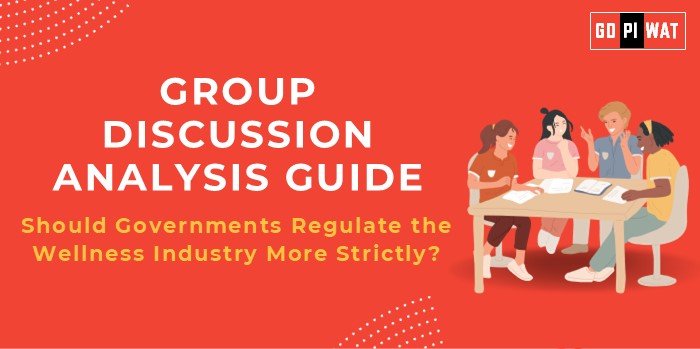📋 Group Discussion (GD) Analysis Guide: Should Governments Regulate the Wellness Industry More Strictly?
🌐 Introduction to the Wellness Industry
Opening Context: “The wellness industry, valued at $4.4 trillion globally, is among the fastest-growing sectors, driven by rising health awareness and lifestyle changes. However, with growth comes challenges, including unverified claims and consumer exploitation.”
Topic Background: The wellness industry encompasses fitness, nutrition, mental health, and alternative therapies. Governments worldwide face growing pressure to regulate this booming sector due to potential risks like false advertising, health hazards, and data misuse.
📊 Quick Facts and Key Statistics
- 🌍 Global Market Size: $4.4 trillion (2023) – Highlights the sector’s economic significance.
- 📈 Growth Rate: 5-10% CAGR – Indicates its rapid expansion.
- ⚠️ Consumer Issues: Over 50% of wellness products/services globally lack clinical validation.
- 📱 Digital Wellness Boom: Apps and wearables constitute 10% of the market, raising data privacy concerns.
- 🏛️ Regulation Gap: Only 20% of countries enforce comprehensive wellness standards.
👥 Stakeholders and Their Roles
- 🏛️ Governments: Frame regulations, monitor practices, and ensure consumer safety.
- 💼 Industry Players: Innovate and provide wellness products/services responsibly.
- 👥 Consumers: Demand transparency and authenticity.
- 🩺 Healthcare Experts: Validate scientific claims and promote evidence-based practices.
🏆 Achievements and Challenges
Achievements:
- 💰 Economic Growth: Wellness contributes significantly to GDP and employment.
- 🧘♀️ Health Awareness: Rising focus on preventive healthcare and mental well-being.
- 🤖 Innovation: Growth of technology-driven wellness solutions like fitness trackers and AI health apps.
Challenges:
- ⚠️ Misinformation: Unverified health claims in products and services.
- 💸 Accessibility: High costs make wellness inaccessible to underprivileged sections.
- 🔐 Data Privacy: Rising misuse of personal health data by wellness apps.
🌏 Global Comparisons:
- 🇯🇵 Strict Regulation: Japan enforces rigorous wellness product certifications.
- 🇺🇸 Minimal Regulation: The US faces criticism for inadequate oversight of supplements.
📖 Case Study:
India: Rising concerns over Ayurvedic products with high heavy metal content highlight the need for stringent quality checks.
📚 Structured Arguments for Discussion
- ✅ Supporting Stance: “Governments must regulate the wellness industry to protect public health, ensure product safety, and foster consumer trust.”
- ❌ Opposing Stance: “Overregulation might stifle innovation and increase costs, making wellness solutions less accessible.”
- ⚖️ Balanced Perspective: “While regulation is necessary for consumer safety, a balanced approach can promote innovation without compromising standards.”
🎯 Effective Discussion Approaches
- 💡 Opening Approaches:
- “The wellness industry, growing at 5-10% annually, lacks standardized regulations, risking consumer health and trust.”
- “The heavy metal contamination in wellness products raises urgent regulatory concerns in India.”
- 🛠️ Counter-Argument Handling:
- “Innovation thrives in regulated environments where consumer trust ensures long-term growth.”
- “Smart regulations focusing on transparency and quality won’t hinder but enhance industry potential.”
🔍 Strategic Analysis of Strengths and Weaknesses
Strengths:
- 📈 Economic growth, preventive health focus, job creation.
Weaknesses:
- ⚠️ Lack of standards, misinformation, affordability issues.
Opportunities:
- 🌟 Technology integration, global market expansion.
Threats:
- 🔐 Privacy breaches, overregulation risks.
🎓 Connecting with B-School Applications
- 🌟 Real-World Applications: Topics like consumer behavior analysis, ethical business practices, and regulatory strategy align with MBA themes.
- ❓ Sample Interview Questions:
- “How can technology improve regulation in the wellness industry?”
- “Evaluate the role of government policies in consumer protection.”
- 📘 Insights for B-School Students: Importance of ethical innovation; regulatory frameworks’ impact on business strategy; consumer trust as a driver of long-term success.


